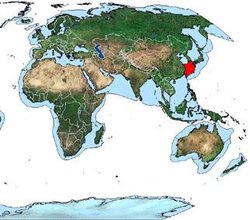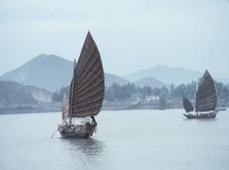East China Sea large marine ecosystem
 Location of the East China Sea Large Marine Ecosystem. (Source: NOAA)
Location of the East China Sea Large Marine Ecosystem. (Source: NOAA) The East China Sea Large Marine Ecosystem (LME) is a vast, semi-enclosed LME bordered by China, South Korea, and Japan. It extends to the Taiwan Strait and is bounded to the North by the Yellow Sea LME. The East China Sea LME is influenced by the warm Tsushima Current, which originates in this LME, and by the Kuroshio Current, of higher temperature and salinity, in the south. It is a monsoonal system. It is a productive LME with shallow coastal waters that provide spawning and nursery grounds for many species of pelagic fish. Intensive fishing is the primary force driving the LME, with climate as the secondary driving force. LME book chapters and articles pertaining to this LME include Chen and Shen, 1999.
Contents
- 1 Productivity
- 2 Fish and Fisheries
- 3 Pollution and Ecosystem Health
- 4 Socioeconomic Conditions
- 5 Governance
- 6 References
- 6.1 Articles and LME Volumes Chen, Y.Q., and X.Q. Shen, 1999. Changes in the Biomass of the East China Sea Ecosystem. In Kenneth Sherman and Qisheng Tang (eds), Large Marine Ecosystems of the Pacific Rim-Assessment, Sustainability, and Management. (Blackwell Science) pp. 221-239. ISBN: 0632043369 (East China Sea large marine ecosystem) . * Morgan, Joseph. 1989. Large marine ecosystems in the Pacific Ocean. In K. Sherman and L.M. Alexander, eds. Biomass Yields and Geography of Large Marine Ecosystems. AAAS Selected Symposium 111. Westview Press, Boulder CO. 377-394. ISBN: 0813378443. * Terazaki, Makoto. 1989. Recent large-scale changes in the biomass of the Kuroshio Current ecosystem. In K. Sherman and L.M. Alexander, eds. Biomass Yields and Geography of Large Marine Ecosystems. AAAS Selected Symposium 111. Westview Press, Boulder CO. 37-65. ISBN: 0813378443.
- 6.2 Other References
- 6.3 Citation
Productivity
A secondary driving force identified in this LME is climate, and variations in environmental conditions. For more information on climatology and physical oceanography, see Chen and Shen, 1999. Typhoons and cyclones influence the East China Sea LME. There is an alternation of winter and summer monsoons. The northern wind prevails from September to May, while the southern wind is dominant in the summer months. For maps of sea currents and water masses in winter and summer, see Chen and Shen, 1999. The East China Sea Large Marine Ecosystem is considered a Class I, highly productive (>300 gC/m2-yr) ecosystem based on SeaWiFS global primary productivity estimates. Productivity is influenced by water temperature and by runoff from the many major rivers coming from China’s mainland. The East China Sea’s three major estuaries are the Zhoushan, Wentai and Changkiang (Yangtze). The rivers deliver nutrients that affect the composition, distribution and dynamics of the phytoplankton population. For an analysis of pelagic ecosystems, including phytoplankton, zooplankton and key species, see Chen and Shen, 1999. 209 species of pelagic phytoplankton have been identified. Key phytoplankton species are Nitzchia spp., Coscinodiscus spp., and Skeletonema costatum. There are 600 species of zooplankton. The highest densities of zooplankton occur where coastal waters converge with the Yellow Sea and Kuroshio currents. Natural and anthropogenic changes are leading to an overall reduction in ecological diversity.
Fish and Fisheries
 East China Sea.(Source: NOAA)
East China Sea.(Source: NOAA) The LME is intensively exploited, for fisheries and algae. Significant changes in fisheries biomass have occurred in the past few decades. The cause is an overexploitation of some fisheries resources. Several stocks are declining due to overfishing and water pollution. Today, the average total catch is 3.8 million tons. The catch has steadily increased since the 1960s. The key species in this LME are hairtail, large yellow croaker, small yellow croaker, filefish, mackerel, scad, pomfret, Chinese herring, cuttlefish, jellyfish, shrimp and crab. For graphs of landings by species from the 1960s to 1992, see Chen and Shen, 1999. The heavy fishing mortality has resulted in a shift from an older, traditional fishery based on high-value demersal species to faster-growing, smaller, and lower-value species such as shrimp and cephalopods. There are changes occurring in catch composition and ecological diversity. For more information on catch per unit effort, species composition and size shifts, see Chen and Shen, 1999. Some of the landings are used for feeding cultured fish or poultry. While traditional species are overexploited, there is still a potential for a further exploitation of certain pelagic, mid-water species. The University of British Columbia Fisheries Center has detailed fish catch statistics for this LME. A graph of the data is available by clicking on the figure below.
Pollution and Ecosystem Health
Both natural and anthropogenic changes are occurring in the East China Sea LME. This is leading to an overall reduction in ecological diversity, and causing harm to marine organisms and fisheries (Fisheries and aquaculture) resources, especially in coastal and estuarine waters where important nursery, fishing and feeding grounds are located. Coastal China is a major economic area characterized by rapid economic development and a growing population. This has led to significant increases of wastewater and sewage discharge into the East China Sea LME, with eutrophication and frequent red tides as the harmful results of this development. For more information on red tides in this LME, see Chen and Shen, 1999. A serious red tide occurs every year from May to July in Sanmen Bay and Louqing Bay. Summer red tide events and toxic blooms are increasing. Fisheries resources and mariculture operations are affected by these events. The public has experienced health problems as a result of these events. A recent report by the Chinese government provides information on the status of pollution in the East China Sea.
Socioeconomic Conditions
 East China Sea.(Source: NOAA)
East China Sea.(Source: NOAA) The Eastern China region is an important economic area that is experiencing rapid economic development and a fast population growth (Human population explosion). China has been fishing in this LME for a long time. The development of a fishing industry was slow until the 1950s. In the 1960s and 1970s, the surrounding countries and especially the two Koreas, Japan and Taiwan began to overexploit the LME’s fisheries. Mariculture is a growing economic activity in the region.
Governance
The countries involved in the governance of the East China Sea LME are China, Japan and South Korea. Additional countries are exploiting the LME’s fisheries resources. An important governance initiative will be to take measures to recover depleted fisheries resources and improve ecological and environmental conditions. There is a need to reduce fishing efforts from the current high levels, and limit the number of fishing vessels with access to the LME. The species most in need of protection are some bottom species and traditional species such as large and small croaker, cuttlefish and jellyfish. Appropriate laws and regulations will need to be enacted in order to protect fishing grounds and fisheries (Fisheries and aquaculture) resources. There is a need for better international coordination between China, Japan, the two Koreas and Hong Kong. Large-scale and comprehensive studies of the LME’s marine [[ecosystem]s] and pollution levels are necessary, with more scientific exchange between the countries. Since the 1990s, China has been experiencing a wave of economic reforms.
References
Articles and LME Volumes Chen, Y.Q., and X.Q. Shen, 1999. Changes in the Biomass of the East China Sea Ecosystem. In Kenneth Sherman and Qisheng Tang (eds), Large Marine Ecosystems of the Pacific Rim-Assessment, Sustainability, and Management. (Blackwell Science) pp. 221-239. ISBN: 0632043369 (East China Sea large marine ecosystem) . * Morgan, Joseph. 1989. Large marine ecosystems in the Pacific Ocean. In K. Sherman and L.M. Alexander, eds. Biomass Yields and Geography of Large Marine Ecosystems. AAAS Selected Symposium 111. Westview Press, Boulder CO. 377-394. ISBN: 0813378443. * Terazaki, Makoto. 1989. Recent large-scale changes in the biomass of the Kuroshio Current ecosystem. In K. Sherman and L.M. Alexander, eds. Biomass Yields and Geography of Large Marine Ecosystems. AAAS Selected Symposium 111. Westview Press, Boulder CO. 37-65. ISBN: 0813378443.
Other References
- Dou, Z-X., et al, 1979. Chinese Natural Geography, Marine Geography (in Chinese). Science Press, pp. 92-149.
- Marine Fishery Resources Investigation and Division of the Area of the East China Sea (in Chinese), 1987. East China Normal University Press, pp. 24-94.
- NOAA. 1991. Report of the ad hoc Committee on Large Marine Ecosystems. NOAA Technical Memorandum NMFS-F/NEC-92, 19p.
| Disclaimer: This article contains information that was originally published by the National Oceanic and Atmospheric Administration (NOAA). Topic editors and authors for the Encyclopedia of Earth have edited its content and added new information. The use of information from the National Oceanic and Atmospheric Administration (NOAA) should not be construed as support for or endorsement by that organization for any new information added by EoE personnel, or for any editing of the original content. |